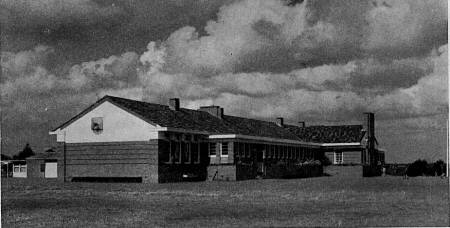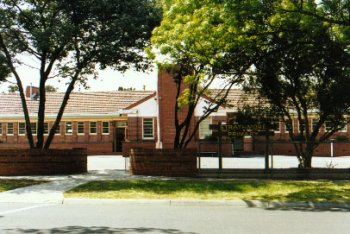|
Strathmore Community History |
| ► | Home Page |
| ► | History
Home Page |
Strathmore Primary School
 Strathmore Primary School 1956 |
School No. 4612 The information below is an excerpt of a history compiled by Mr. E.W. McCarthy, then Principal of Strathmore Primary School in 1969 for the 25th anniversary of the School. - as reproduced in the publication for the 50th Anniversary of the Strathmore Primary School. |
|
"In the early 1920's all the land North of Woodland Street was Subdivided into building allotments. By 1928 quite a number of homes had been erected and the Strathmore Progress Association, realizing the necessity for primary educational facilities approached the then Minister of Education, Mr. H. J. Cohen M.L.A., by way of a deputation suggesting a site in Bournian Avenue, North of Grammar Street be secured. The Department considered the request premature and nothing eventuated. The Progress Association continued its efforts over the years but, due principally to the period of depression, 1930 -1935, no tangible progress was made. In 1938 a deputation comprising Cr Lockart, President of the Shire of Broadmeadows, together with Crs W. H. Henshall and E. E. Hughes and representatives of the Progress Association, was introduced by Mr. J. C. Dillon, M.L.A. to the Minister of Education, Sir John Harris, with a request that a School be provided for the district. The Minister made it quite plain that unless the necessary land was presented to the Department, he could not consider a school. To Quote the words of Sir John Harris - "You provide the land and we will provide the school". The district was now growing rapidly, at a rate of approximately 100 houses each year. There were many young children having to walk long distances to Essendon and Keilor Road schools and the matter was regarded as urgent by the residents. Broadmeadows Council, realising nothing was likely to eventuate unless the land was secured, decided to borrow money to obtain the approximate four acres required at an approximate cost of 2500 pounds. Upon completion of the land purchase the Councillors again waited on Sir John Harris, asking for a school to be erected on land to be donated to the Department. The Minister, in reply, denied that he had previously promised or even implied that a school would be provided. Mr J. C. Dillon M.L.A. for Essendon, was untiring in his efforts to have this unfortunate situation rectified but it was not until 1942, when Sir Albert Lind was Appointed Minister for Education, that any substantial progress was made. When the whole position was placed before the Minister by Dillon, his interest and sympathy were quickly obtained and he personally inspected the area in December 1942. He promised early action to see that the district had a school with all possible speed. In May 1943 advice was received from the Minister that finance had been arranged and the plans were in the course of preparation. Eventually tenders where called for a brick building of four classrooms and a Head Teacher's office. In late 1943 a contract was let to Mr Wilson, a builder of Bacchus Marsh, and the building was expected to be ready about the middle of 1944. Due to wartime conditions, causing shortages of manpower and materials, considerable delay occurred and the Department officials decided to commence the school on 5th September 1944, with the building still incomplete. Mr Cerchi was appointed temporary Head Teacher with two lady assistants, 42 pupils enrolled. Teaching was carried on under extreme difficulties until the completion of the building works in February 1945. The permanent Head Teacher, Mr. D. Griffin was appointed in 1945 and the enrolment was approximately 80 and growing steadily. After many years of frustration and disappointments, residents and parents were entitled to expect that it was now only a matter of consolidation for the success and growth of the school but this was not to be. On November 28th, 1945 the building was burned out and completely gutted with only the brick walls left standing. This was a bitter blow to all connected with the school after the many difficulties in becoming established during wartime. The children and staff were housed temporarily at the Essendon State School where, fortunately, there was spare accommodation. The rebuilding of Strathmore State School was again a slow and tedious job and it was not until the end of 1946 that it was restored. In 1948, after representations by the School committee, the Education Department purchased an additional six building blocks making the total area up to approximately five acres. At the commencement of 1948 the enrolment was approximately 200 and the committee requested the Department for extensions. Two more classrooms were added as a result. From this time on steady growth took place. The forthgoing resume covers the period up to the end of 1948, whilst the various incidents and happenings have been dealt with in a brief manner, it is not an exaggeration to say that the difficulties encountered in the establishment of the school during war-time were terrific. Those connected with the present day school should be thankful for what they receive. When Strathmore No. 4612 was finally established the parents were grateful to get a building with desks and blackboards together with staff. The School Committee had to start from there but the students responded magnificently in the raising of funds for those amenities so necessary for the proper functioning of a school. Fetes, bazaars, house functions,dances and family nights to hurricane and tilly lamps all helped raise fund and at the same time, to weld the staff, parents and children into one happy family. There were no roads built and no prospect of any construction during wartime. In winter the black mud was terrible and the school floor was permanently black. There was no electricity; indeed there was only six houses in the whole area south of Hayes Road. The school site had been chosen as the centre of the future development of the area and the early inhabitants had to accept this fact. After the fire all the work had to start over again. All of this during war - time when practically everything was restricted or rationed. It is only those who lived through that period who can visualize the difficulties encountered." |
Links: Facebook page: Strathmore Primary School 70th Anniversary.
Source:
A history compiled by Mr. E.W. McCarthy, then Principal of Strathmore Primary School in 1969 for the 25th anniversary of the School. - as reproduced in the publication for the 50th Anniversary of the Strathmore Primary School. (Reproduced with Permission.) For further information on the history of the school please look at that source or look at our Further Information page.
| Primary School (1998) |
 |
| | Home | Top of Page | | | Site Information | (C) | |
